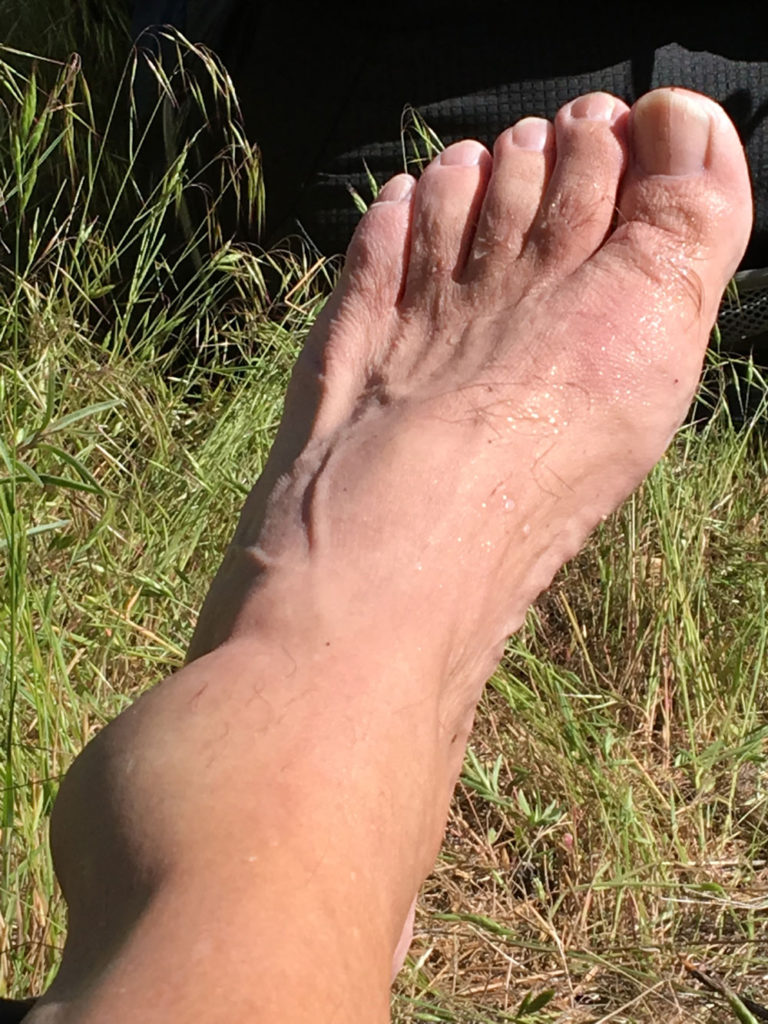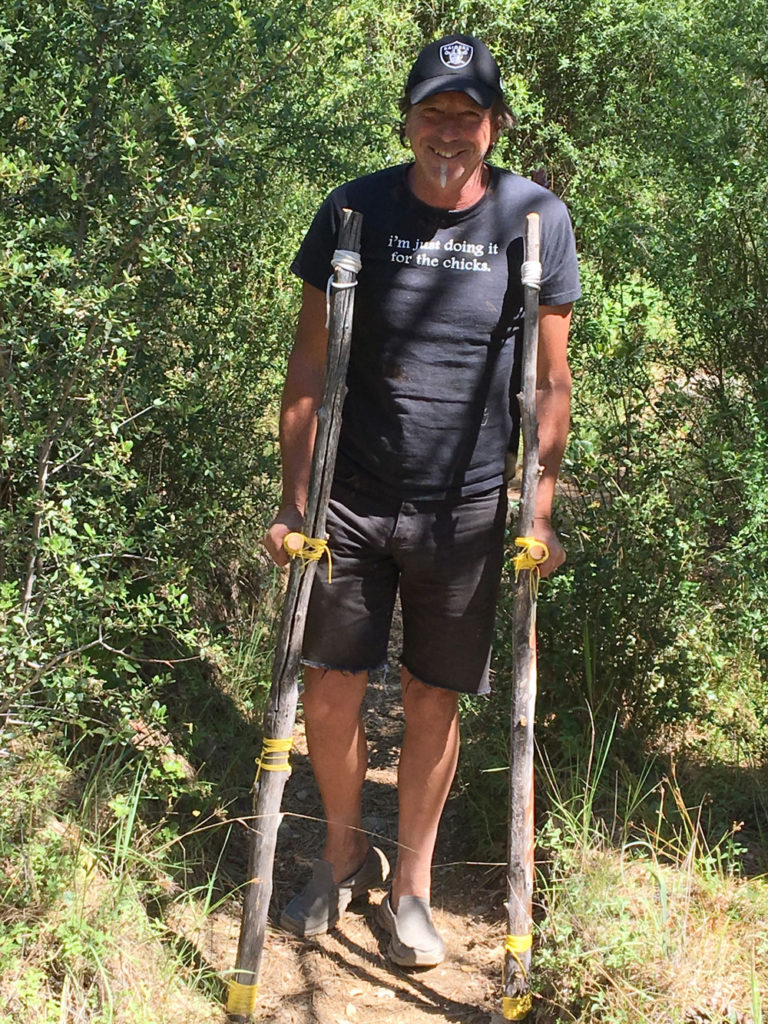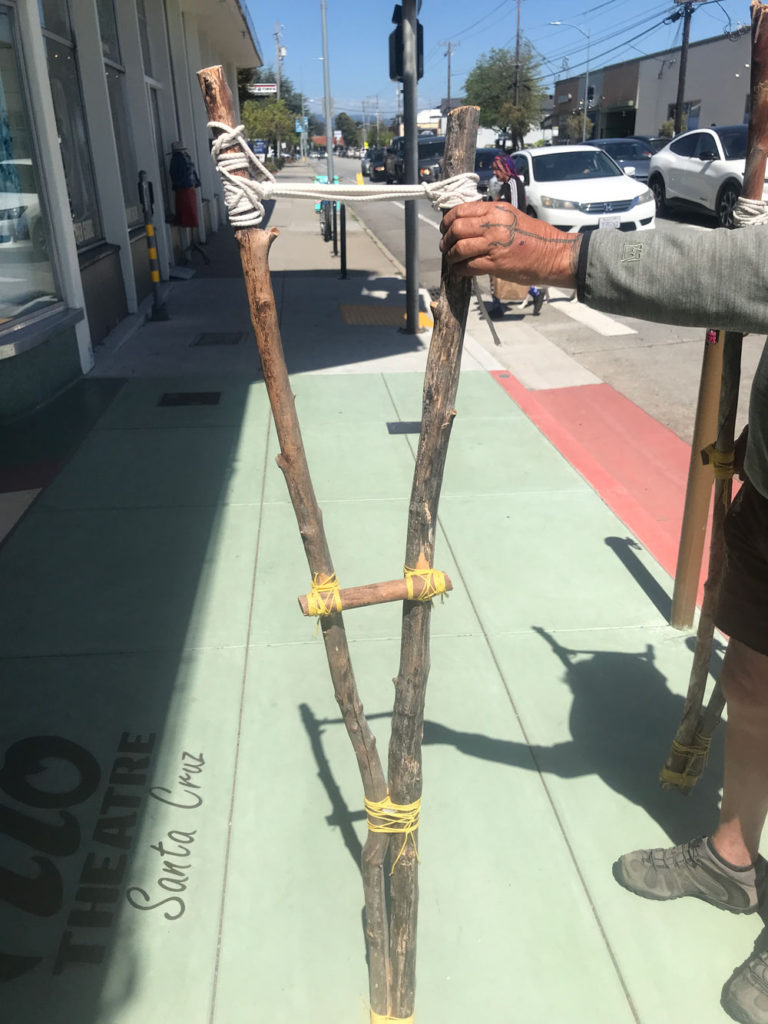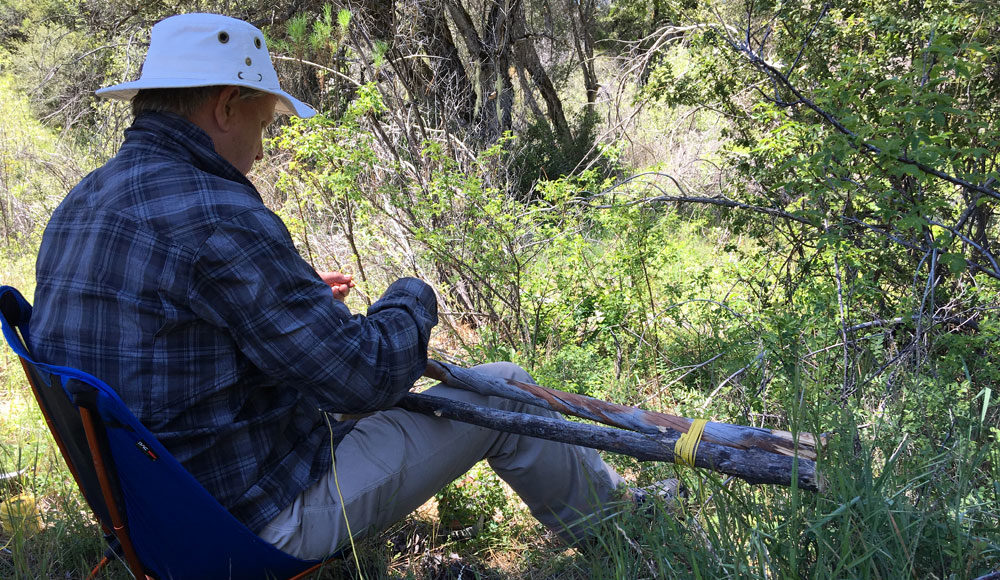Laurence Bedford tells me that for his hiking buddy Sven Davis, “Minimalism gets to be a religion.” Laurence grins and explains that Sven cut the handle off his toothbrush to save the weight. And that as Sven reads his books, he tears out the pages that he’s read and burns them in the campfire.
“Sven uses one cup, for tequila at night, and the next morning your oatmeal smells like tequila,” Laurence says.
According to naturalist John Muir, a good way to start a hike is to “throw a loaf of bread and a pound of tea in an old sack and jump over the back fence.”
And that’s what Sven and Laurence set off to do: a camping trip in Big Sur up in Carmel Valley. They parked Sven’s old Subaru near China Camp, put on their packs and walk down the Pine Valley Trail, intending to hike four miles and set up camp in a meadow for a few days. Their hike started perfectly on a gorgeous spring day, and they were getting close to the meadow.
Laurence recounts the trip to me: “It was our alcohol-free trip, we didn’t have anything to nip on.” They did three and a half miles and were not far from their meadow destination.
The Sound of a Hike Changing
The two friends were walking under an ancient, giant tree, shooting the shit.
Laurence said, “Hey Sven, you know those pumas and cougars?”
As Laurence walked, he turned his head to look back at Sven.
“They sleep in the trees during the day. We’re always looking for them in the grass. But they could be right up there.”
The two men made eye contact to consider the imagined cougar in the tree, when they both heard a sharp crack from Laurence’s ankle. Sven said that he could feel the sound. They continued looking at each other, knowing their future had just changed.
Sven remembers, “Three and a half miles in and suddenly Lawrence’s ankle just goes pop. Like he just stepped on something weird. It literally made a noise. I said, ‘Let’s sit down for a minute. Let’s take stock on what’s going on here.’ It was kind of obvious that he hurt it, and so we hobbled over to the creek nearby.”
Laurence remembers, “Yeah, there is a moment of panic, you know, something just went crack in my ankle and I could feel it swelling. It swelled up really, really fast. When you don’t know if it was broken, when you don’t know what you’re dealing with … your mind now is racing. We’re in the fucking middle of nowhere.”
OutdoorLife.com says, “The first part of surviving an injury is immobilizing the moving parts. It’s always best to immobilize the next joint up from the injury, if possible. If an ankle seems sprained, immobilize it up to the knee.”

They didn’t know what to do. They knew they weren’t walking out that day and knew they didn’t want to get airlifted. They didn’t have cell phone reception anyway. And they also knew the old adage, “You don’t take your boot off because the swelling will ever not let you put the boot back on.”
I ask Laurence, “So what happened to your ankle?”
“My foot got caught and then snapped.”
Wilderness First Aid says, if something happens to you like that, they tell you not to take your boots off because you’ll never be able to put it back on. Your boot is supposed to contain the swelling.
Laurence explains that he was near a cold stream. “Instead, I took my boot off and stuck my foot into the cold stream. We had supplies for two, three days. I was like, ‘Hey, this is a good place.’ I could barely get my tent together. I was right next to the water, and we made a fire.”
It took one full day with his foot in cold water to contain the swelling. Laurence slept in his tent on the bank with his foot in the water for 23 hours. The swelling stabilized. On the second day, Sven started making crutches, using knots he had learned to tie in the Boy Scouts. The next morning, they tested them and the crutches worked. Laurence could plant both crutches out in front of him and then swing his body forward, land on his good right foot, replant the crutches in front of him and keep swinging forward. It was faster than walking.
Crutches for a Man with Tape
Laurence tells me, “The second day Sven engineered the crutches and, you know, you always have duct tape. You always have nylon string, you know; there you have basic stuff that you always have with you.”
I interrupt Laurence’s story, “Wait a minute, wait a minute. You always have duct tape with you? You’re hiking and you have duct tape?”
“Yes! Always have duct tape.”
An Outdoor Life Survival Skill manual agrees that duct tape can help when assembling a crutch in the wild: “The fork should be heavily padded by wrapping it with clothing or another soft material. A little duct tape works well.”
Laurence had a four-inch saw on a knife, but just as Sven assembled his long sticks to start in with the little saw, a passing hiker stopped and unfolded a large crosscut saw and Sven cut his sticks in a few minutes.

The crutches worked perfectly. His left foot never touched the ground, and he developed a swinging cadence that outpaced Sven. “You just put both of them down at the same time. You swing forward and land on your one good foot. My left foot never really had to touch the ground.” Laurence was deeply impressed by Sven’s crutches. “You know, they stood up to my weight and everything. I mean, the engineering was great.”
So, they were home free, with Laurence swinging his body through his crutches, clipping along fast, and Sven goes, “Like, dude, stop! Listen! There is a rattlesnake just hanging on the trail.”
Laurence says, “The rattlesnake came out of the grass and then started coming forward. I heard the rattle but didn’t know where it was. It was coming across the path at us. I backed up and then Sven came up with a tree branch and encouraged it into the woods. We continued our journey and made it out in record time.”

Ladybug, Ladybug ... Your House Is on Fire
Laurence’s grapefruit ankle turned out to be a severe sprain and got better. He wanted to return to get his backpack and gear but was delayed by the Big Sur fires and floods of 2018.
“We had taken pictures of the locale and the tree. I had documentation of where that pack was so we could go back and get it. We had to go through two seasons of fire and flood. I didn’t end up going back up there for two years.”
“The 2018 wildfire season was the deadliest and most destructive wildfire season on record in California, with a total of over 7,500 fires burning an area of over 1,670,000 acres, the largest area of burned acreage recorded in a fire season.” (fire.ca.gov)
Laurence returned to the Pine Valley trail in 2019 to find that the big tree, his pack, and the whole forest were gone.
Laurence keeps Sven’s crutches in his office at the Rio Theatre.













